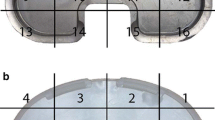Abstract
With greater numbers of primary knee replacements now performed in younger patients there is a demand for improved performance. Surface roughness of the femoral component has been proposed as a causative mechanism for premature prosthesis failure. Nineteen retrieved total knee replacements were analysed using a non-contacting profilometer to measure the femoral component surface roughness. The Hood technique was used to analyse the wear and surface damage of the matching ultra-high molecular weight polyethylene (UHMWPE) tibial components. All femoral components were shown to be up to 11× rougher after their time in vivo while 95 % showed a change in skewness, further indicating wear. This increase in roughness occurred relatively soon after implantation (within 1 year) and remained unchanged thereafter. Mostly, this roughness was more apparent on the lateral condyle than the medial. This increased femoral surface roughness likely led to damage of the UHMWPE tibial component and increased Hood scores.











Similar content being viewed by others
References
National Joint Registry for England and Wales. 8th Annual Report. 2011.
Losina E, Thornhill TS, Rome BN, Wright J, Katz JN. The dramatic increase in total knee replacement utilization rates in the United States cannot be fully explained by growth in population size and the obesity epidemic. J Bone Joint surg Am. 2012;94(3):201–7.
Losina E, Katz JN. Total knee arthroplasty on the rise in younger patients: are we sure that past performance will guarantee future success? Arthritis Rheum. 2012;64(2):339–41. doi:10.1002/art.33371.
Kurtz S, Mowat F, Ong K, Chan N, Lau E, Halpern M. Prevalence of primary and revision total hip and knee arthroplasty in the United States from 1990 through 2002. J Bone Joint Surg Am. 2005;87A(7):1487–97. doi:10.2106/jbjs.d.02441.
Lavernia C, Lee DJ, Hernandez VH. The increasing financial burden of knee revision surgery in the United States. Clin Orthop Relat Res. 2006;446:221–6. doi:10.1097/01.blo.0000214424.67453.9a.
Gioe TJ, Killeen KK, Grimm K, Mehle S, Scheltema K. Why are total knee replacements revised? Analysis of early revision in a community knee implant registry. Clin Orthop Relat Res. 2004;428:100–6.
Siddique MS, Rao MC, Deehan DJ, Pinder IM. Role of abrasion of the femoral component in revision knee arthroplasty. J Bone Joint Surg Br. 2003;85B(3):393–8. doi:10.1302/0301-620x.85b3.13041.
Que L, Topoleski LDT, Parks NL. Surface roughness of retrieved CoCrMo alloy femoral components from PCA artificial total knee joints. J Biomed Mater Res. 2000;53(1):111–8. doi:10.1002/(sici)1097-4636(2000)53:1<111:aid-jbm15>3.0.co;2-y.
Lakdawala A, Todo S, Scott G. The significance of surface changes on retrieved femoral components after total knee replacement. J Bone Joint Surg Br. 2005;87B(6):796–9. doi:10.1302/0301-620x.87b6.15776.
Cho CH, Murakami T, Sawae Y. Influence of microscopic surface asperities on the wear of ultra-high molecular weight polyethylene in a knee prosthesis. Proc Inst Mech Eng Part H J Eng Med. 2010;224H(4):515–29 doi:10.1243/09544119jeim690.
Burnell CDC, Brandt JM, Petrak MJ, Bourne RB. Posterior condyle surface damage on retrieved femoral knee components. J Arthroplast. 2011;26(8):1460–7. doi:10.1016/j.arth.2011.03.011.
Ohlsson R, Wihlborg A, Westberg H. The accuracy of fast 3D topography measurements. Int J Mach Tools Manuf. 2001;41(13–14):1899–907. doi:10.1016/s0890-6955(01)00054-2.
Blunt L, Jiang XQ. Three dimensional measurement of the surface topography of ceramic and metallic orthopaedic joint prostheses. J Mater Sci Mater Med. 2000;11(4):235–46.
Hood RW, Wright TM, Burstein AH. Retrieval analysis of total knee prostheses: a method and its application to 48 total condylar prostheses. J Biomed Mater Res. 1983;17(5):829–42. doi:10.1002/jbm.820170510.
Kurtz SM. The UHMWPE biomaterials handbook: ultra-high molecular weight polyethylene in total joint replacement and medical devices, vol. 2. Burlington: Academy Press; 2009.
Dowson D, Taheri S, Wallbridge NC. The role of counterface imperfections in the wear of polyethylene. Wear. 1987;119(3):277–93. doi:10.1016/0043-1648(87)90036-6.
Fisher J, Firkins P, Reeves EA, Hailey JL, Isaac GH. The influence of scratches to metallic counterfaces on the wear of ultra-high molecular weight polyethylene. Proc Inst Mech Eng Part H J Eng Med. 1995;209(4):263–4. doi:10.1243/pime_proc_1995_209_353_02.
Bowsher JG, Shelton JC. Hip simulator study of the influence of patient activity level on the wear of crosslinked polyethylene under smooth and roughened femoral conditions. Wear. 2001;250:167–79. doi:10.1016/s0043-1648(01)00619-6.
Muratoglu OK, Burroughs BR, Bragdon CR, Christensen S, Lozynsky A, Harris WH. Knee simulator wear of polyethylene tibias articulating against explanted rough femoral components. Clin Orthop Relat Res. 2004;428:108–13. doi:10.1097/01.blo.0000143801.41885.8b.
DesJardins JD, Burnikel B, LaBerge M. UHMWPE wear against roughened oxidized zirconium and CoCr femoral knee components during force-controlled simulation. Wear. 2008;264(3–4):245–56. doi:10.1016/j.wear.2007.03.020.
Collier JP, Sperling DK, Currier JH, Sutula LC, Saum KA, Mayor MB. Impact of gamma sterilization on clinical performance of polyethylene in the knee. J Arthroplast. 1996;11(4):377–89. doi:10.1016/s0883-5403(96)80026-x.
Kennedy FE, Currier JH, Plumet S, Duda JL, Gestwick DP, Collier JP, et al. Contact fatigue failure of ultra-high molecular weight polyethylene bearing components of knee prostheses. J Tribol Trans ASME. 2000;122(1):332–9. doi:10.1115/1.555364.
Acknowledgments
The funding for this work was provided by a Knowledge Transfer Account (KTA). This KTA came from an Engineering and Physical Sciences Research Council (EPSRC) award given to Newcastle and Durham Universities. None of the authors hold any professional or financial affiliations that may be perceived to have biased the presentation.
Author information
Authors and Affiliations
Corresponding author
Rights and permissions
About this article
Cite this article
Scholes, S.C., Kennard, E., Gangadharan, R. et al. Topographical analysis of the femoral components of ex vivo total knee replacements. J Mater Sci: Mater Med 24, 547–554 (2013). https://doi.org/10.1007/s10856-012-4815-z
Received:
Accepted:
Published:
Issue Date:
DOI: https://doi.org/10.1007/s10856-012-4815-z




